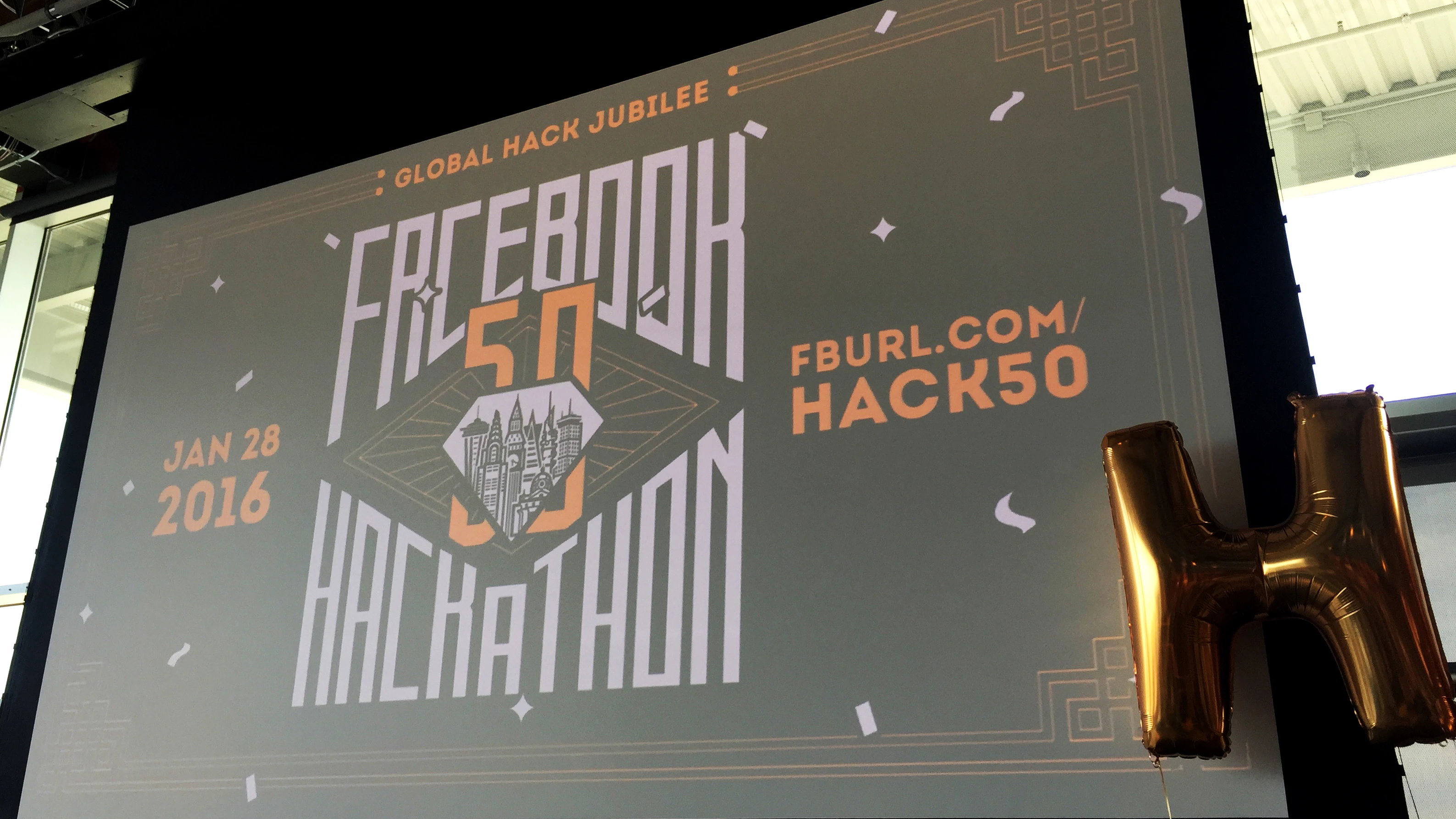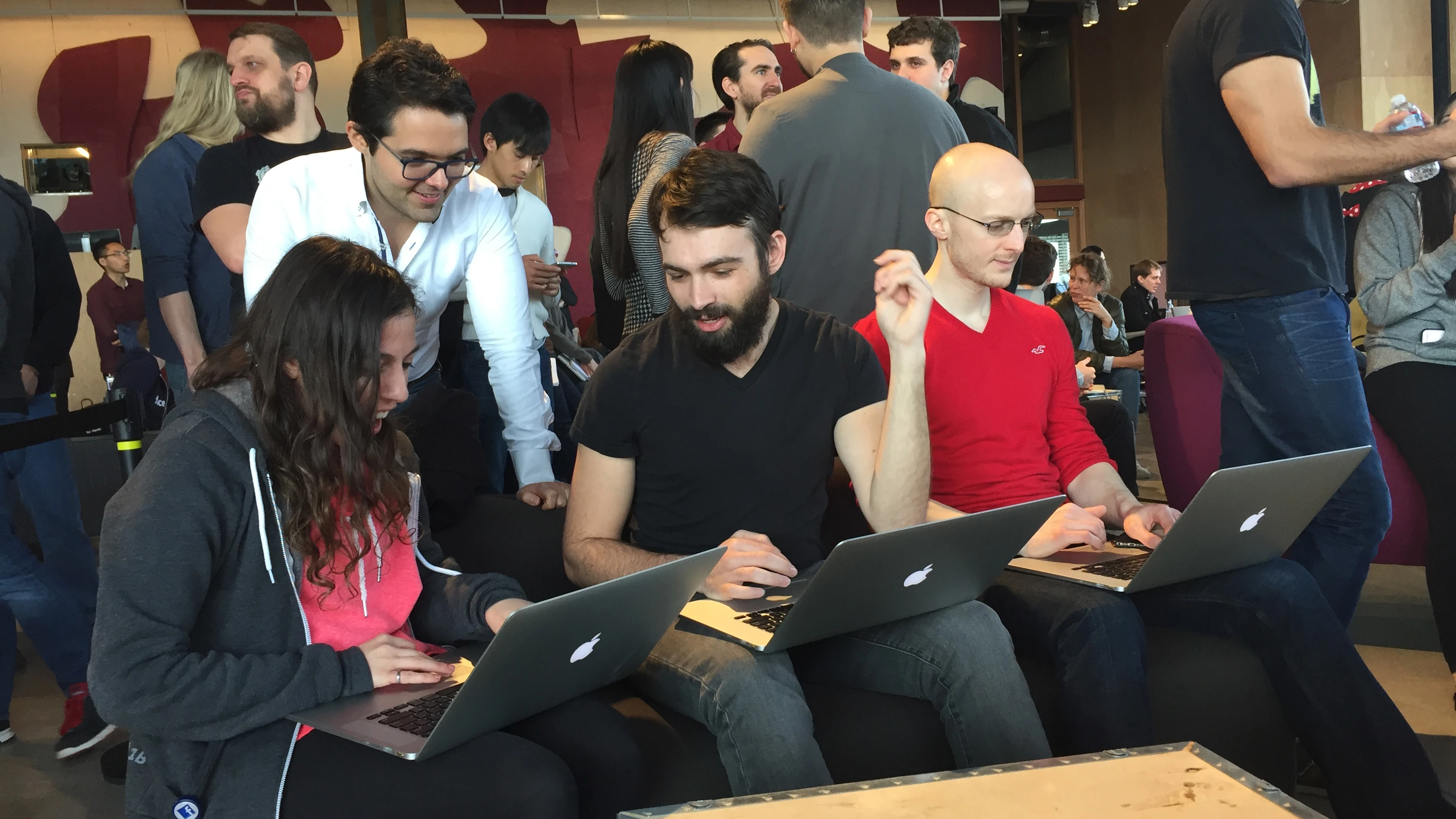Mark Zuckerberg, wearing his trademark gray shirt, stood on a small stage at the front of a large room, a set of six gold-colored helium balloons hovering in the air behind him.
The balloons spelled out “HACK 50,” and were perhaps the most ostentatious evidence that today, here at Building 20, the Frank Gehry-designed Facebook headquarters in Silicon Valley’s Menlo Park, is the company’s 50th hackathon, a 24-hour event during which hundreds of engineers tackle ideas outside of their normal work areas.

It’s also the first to focus in large part on artificial intelligence.
“The idea today is to focus on applications of AI, the idea that there are so many new technologies that are getting built around pattern matching . . . image recognition, face recognition, speech, [and] language,” Zuckerberg told the gathering of a couple hundred Facebook engineers. “All of these different areas of AI and pattern matching, and we think we’re really at the beginning of this, which is why we have such a big focus on this as a company.”
Zuckerberg, of course, is all in on AI at a personal level. Every year, the Facebook CEO announces a personal challenge, and this year, he has set out to build himself an AI system capable of running his house, a kind of butler, or Jarvis-from-Iron Man for the home.
And Zuckerberg knows well the power of setting Facebook engineers loose to work on projects outside their normal domain. The previous 49 hackathons over the last 10 years, Zuck recalls, have spawned a variety of riches, like Facebook’s chat tool, its first video and notes product, an early development platform, its first mobile ads product, and more recently, Instagram’s Hyperlapse tool and Facebook’s Safety Check.
“We have this saying at Facebook that code wins arguments,” Zuckerberg said. “The idea isn’t that you’re going to build something in one day that is fully formed that you can then go ship. That, I don’t think, is the way the world works.”
“But,” Zuckerberg said, “what you can do is, instead of having these abstract debates about whether something is a good idea, you can put something down in code, and a lot of the debates that you might have about, ‘Oh, is this interaction going to work or be good enough to be a viable thing?’–you can show that that’s the case in a day.”
The ideas people come up with at hackathons, Zuckerberg added, influence “the product road map that all the teams have at the company, and it ends up being how we incorporate a very large percent of what we build at the company.”

To Facebook’s leadership, one of the best things about the hackathons is that they bring people from very different teams together, and it’s a terrific place for someone looking to find help for a project from other parts of the company to find collaborators.
“They’ve come together by passion, by organizational structure, or function,” said Facebook’s CTO Mike Schroepfer, “and that’s the explicit intent. And so you see a lot of really good things pop out of this as a result.”
Schroepfer noted that there’s a widely misunderstood gap between good ideas and executing them. There are many subtle differences in a broad idea like “sharing photos,” he said, and it takes being very specific to differentiate them, and understand what will work in a product. In that, then, building the feature is the best way to demonstrate what works.
“Instead of me trying to write a white paper on what this product is going to do,” he said, “I hand you a thumb-drive and you try it out.”
A hackathon, then, is a great place for showing what works and what doesn’t. Sometimes an idea may not sound great, but when someone builds it, it turns out to be great. Or, alternatively, it sounds great, but turns out to be terrible. All of those outcomes are the goal of Facebook’s hackathons.
Ultimately, it doesn’t matter whether people’s hackathon projects are successful or not. Either way, Schroepfer explained, people learn valuable lessons.
Now’s The Time For AI
As Vincent Cheung, Facebook’s AI demo team lead, put it, AI is very much in the news every day, and lots of people at Facebook are interested in it. But not very many people know how to use it, let alone implement it in their products.
That’s why Yann Lecun, the head of Facebook’s AI Research group (FAIR), asked him six months ago to create more demos of the work being done in AI at the company.
“People inside the company didn’t know what we were working on in terms of AI,” Cheung said, “so how do we expect people outside the company to know what we’re working on?”
That led to the creation of a number of demos, and Cheung and his team have been working to centralize the work–the demos and documentation–so that engineers at Facebook can discover it.

“People don’t even know what we can do,” Cheung said. “If you already know what you can do, it’s easier to find the answer. So try to get more heads thinking about AI . . . exposing them to the current state of the technology that we have. Let them play with the technology. And then unleash 12,000 employees to come up with new ways” of using AI across all of Facebook’s apps, including Instagram, Messenger, and WhatsApp.
“Whatever resources we can give them,” Cheung said, “we invite them to just reach out to any of the point of contacts for the people that are actually developing the technologies, to help them come up with new ideas, or figure out the limitation of the new technologies.”
A few hundred people expressed an interest in building something together with AI during the hackathon, Cheung said, but no one will know until it’s over how many actually went in that direction. “Hopefully we get a lot of great ideas and shippable products from this,” he said.
Open Culture
Another advantage of Facebook’s hackathons is that they provide a good reason for people from one part of the company to work on code built by those in other areas. That, Schroepfer argues, is a function of the company’s open culture. It’s also the very nature of the hackathons.
“The most important thing about our hackathons is that they’re completely bottom-up,” Schroepfer said. “I don’t schedule them, and Zuck doesn’t schedule them. It’s a set of volunteer engineers who are like, ‘Hey, we haven’t had a hackathon in a while, let’s do one.’”
That sense of openness extends to Facebook’s vast code base.
“The free flow of information and technologies within Facebook enables hacks in a way that I think may be very difficult in other organizations,” Schroepfer said. “So, [there’s] this idea that I as an engineer can go work on any piece of source code in the company. I don’t have to go ask for a team’s permission to get access to their code. It’s all on one source control repository . . . I think that enables a level of creativity that in other companies you wouldn’t be able to have, because sometimes they silo off the technology between teams.”
What Happens To The Hacks?
Facebook hackathons tend to be 24-hour affairs. Starting in the late morning, they go all night and into the next day. Those who stay late get a 1 a.m. meal and special T-shirts.
“That’s how you know who the real hackers are,” Cheung said. “Their projects are going well enough that they stick around for food” at 1 a.m.
The reality is that some teams will work on their hacks even after the 24-hour event ends. And about a week later, every team will present their work in front of a gathering of engineers and executives known as prototype forums.
Some teams’ projects are clear crowd favorites, Schroepfer said, but every possible outcome has happened. After the demonstrations, he, along with Zuckerberg, vice president of engineering Jay Parikh, and vice president of product Chris Cox get together and review the projects.
Related: How Does Mark Zuckerberg Generate Innovation?
“Usually the feedback is, ‘That’s amazing, go ship that,’” Schroepfer said. “‘Go work on that right now,’ ‘Hey this is really useful for this other team that’s working in this area, let’s hand it off to them,’ or ‘Hey, this is neat, but it needs some revision, try it again next time.’”
One thing that’s changed over the course of 50 hackathons is that the bar has raised for what ships, and it will keep on getting higher. Facebook is “a product used by a good fraction of the world’s population,” he said, “and we want to make sure that the changes we push are better for the product and the people who use it.”
Of course, many engineers at Facebook treat their everyday work like a hackathon, with people regularly getting excited about ideas, building them, and shipping them.
“That’s why we have to go do investigative work to figure out exactly what got shipped at the hackathon,” Schroepfer said. “There isn’t a clear gateway for these things. It’s always app spelunking after the fact.”
Recognize your company's culture of innovation by applying to this year's Best Workplaces for Innovators Awards before the extended deadline, April 12.
